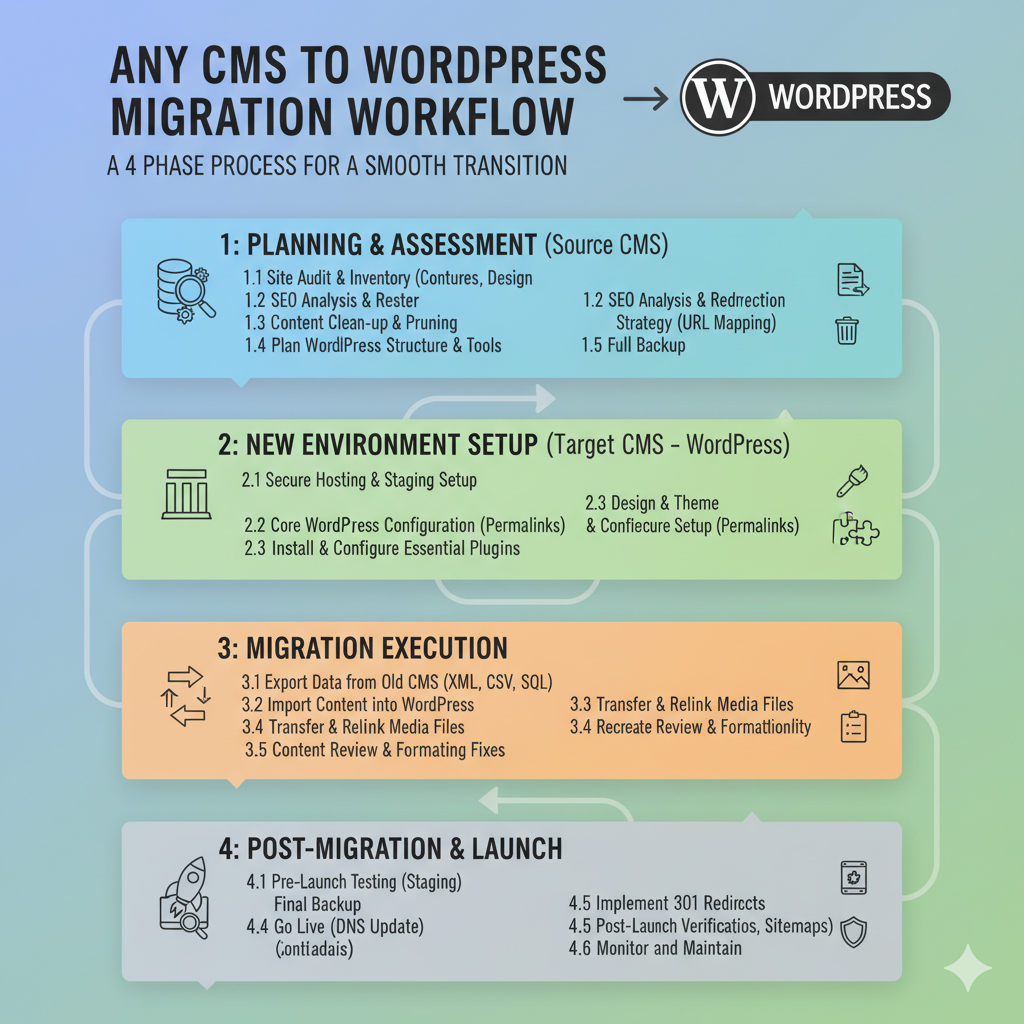Introduction
Migrating a WordPress website might sound simple, but a single mistake can lead to broken links, missing content, or performance issues. Whether you’re switching hosting providers, upgrading your infrastructure, or moving from another CMS to WordPress, a well-planned migration process ensures everything runs smoothly.
I provide WordPress migration services for agencies and businesses of all sizes — from small local sites to complex multisite networks — ensuring minimal downtime, preserved SEO rankings, and full compatibility with the new environment.
If your migration also includes creating a custom theme or plugin adjustments, you may find these articles helpful:
➡️ Custom WordPress Theme Development: From Design to Fully Functional Website
➡️ Custom WordPress Plugin Development: Turning Unique Ideas into Powerful Tools
Types of WordPress Migrations I Handle
Over the years, I’ve migrated websites across dozens of environments and CMS platforms.
Typical migration cases include:
- Between hosting providers – e.g., Hostinger → WP Engine, or Kinsta → HostGator.
- From development to production environments – safely moving projects from staging to live.
- From other CMS platforms – converting sites from Wix, Squarespace, or Umbraco to WordPress.
- From legacy WordPress setups – upgrading outdated themes, plugins, or PHP versions.
- To managed WordPress hosting – optimizing performance on platforms like Kinsta, SiteGround, or WP Engine.
Each case is different, but the goal is always the same: a seamless transition, with zero loss of data and full performance continuity.
The WordPress Migration Process
A successful migration is a step-by-step process that requires careful preparation and execution.
Here’s how I usually handle it:
1. Initial Assessment
Before starting, I review the existing website structure — themes, plugins, database, server configuration, and any custom code that could affect the migration.
2. Backup and Verification
I perform complete backups of both files and databases. This step ensures that, in the unlikely event of a rollback, no data is lost.
3. Environment Preparation
I configure the new hosting environment according to the website’s requirements — PHP version, database settings, SSL certificate, and caching tools.
4. Migration Execution
Using secure tools (such as SFTP, SSH, or WP-CLI), I transfer the entire site while maintaining URLs, permalinks, and plugin configurations.
For database migrations, I carefully replace URLs and serialized data to avoid errors.
5. Testing and Optimization
After migration, I test every aspect of the site: pages, forms, login areas, and performance metrics.
I also run optimizations — clearing caches, checking redirects, and validating SEO meta data.
6. Launch and Post-Migration Support
Once everything is verified, I point the domain to the new server and provide support during the transition period to ensure everything runs as expected.
Contact Me
Looking for a reliable WordPress expert to manage your projects, optimize performance, or create custom solutions?
Let’s make your websites faster, safer, and fully functional — get in touch today!
Migrating from Other CMS Platforms
Many businesses start with tools like Wix, Squarespace, or Umbraco and later outgrow their limitations.
Migrating to WordPress allows for:
- Full control over SEO.
- Custom themes and plugins for unique functionality.
- Integration with CRMs, email marketing, and automation platforms.
- Long-term scalability and easier content management.
Each migration from another CMS involves rebuilding layouts in WordPress — often as a new custom theme — and sometimes developing custom plugins to replicate features from the original system.

Tools and Technologies Used
I rely on professional and secure tools for WordPress migrations:
- WP-CLI and SSH for fast command-line operations.
- SFTP and Rsync for secure file transfers.
- phpMyAdmin or MySQL Workbench for database management.
- Search-Replace-DB for handling serialized data correctly.
- UpdraftPlus and Duplicator for backup and restore operations.
Each project follows strict data-handling standards to ensure privacy and stability during migration.
Common Challenges and How I Avoid Them
Migrating WordPress sites can involve unexpected issues, especially on older or poorly maintained setups.
Here’s how I handle common challenges:
| Challenge | My Approach |
|---|---|
| Broken links or missing media | Automated URL replacement and content validation. |
| Incompatible PHP or plugins | Pre-migration compatibility testing and updates. |
| Downtime or data loss | Full backups and staged migration. |
| Performance drop after migration | Server-level and plugin optimization post-move. |
These precautions guarantee a smooth transition with minimal impact on visitors or search engines.
Hosting Platforms I Work With
I’ve handled migrations across the most popular WordPress hosting platforms, including:
- Hostinger
- HostGator
- WP Engine
- Kinsta
- Locaweb
- SiteGround
- Cloudways
Each provider has different performance configurations, so I adjust caching, CDN, and SSL settings accordingly after migration.
SEO Considerations During Migration
A successful migration also requires protecting your SEO performance.
During and after the migration, I ensure:
- 301 redirects for any changed URLs.
- Updated XML sitemaps submitted to Google Search Console.
- Canonical tags remain correct.
- Page speed remains optimized.
- Structured data and schema are preserved.
This approach helps maintain rankings and prevents traffic loss.
Working with Agencies and Businesses
For agencies managing multiple client websites, I offer fully managed migration support — coordinating DNS updates, staging setup, and testing on your behalf.
For direct business clients, I handle all communication and ensure that the site remains live and stable during the entire migration.
If needed, I also assist with:
- Theme adjustments after migration.
- Plugin troubleshooting.
- Hosting configuration improvements.
Conclusion
Migrating a WordPress website doesn’t have to be risky or stressful.
With the right preparation, secure tools, and testing process, your website can move to a new platform or server without any disruption.
If you’re planning a migration — or need help rebuilding your website with a custom WordPress theme or custom plugin after the move — feel free to get in touch to discuss your project.
